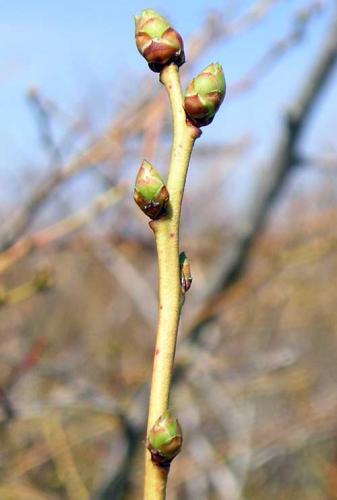Forcing cuttings to determine the end of dormancy in fruits and other plants
Woody plants may be ready to grow. Forcing cuttings can tell you when dormancy is completed.
Since most plants do not grow during the winter, we say they are dormant. There are actually two types of winter dormancy. One is often called endo-dormancy and is when the plants will not grow even if the conditions are warm enough for growth. The other is eco-dormancy and is when the plant does not grow because the conditions are too cold. Endo-dormancy typically prevents plants from growing during winter warm spells.
During endo-dormancy, plants accumulate chilling units when air temperatures generally are above 35 degrees Fahrenheit and below 50 F. Temperatures below freezing or warm temperatures above 55 or 60 F have little effect on chilling hour accumulation. The chilling hours required varies for different plants from 700 to 1,300 hours or more. Chilling and endo-dormancy normally prevent plants from beginning growth during warm spells in the middle of the winter.
The mild weather we have had this winter makes me think that some plants may have already completed their chilling requirement and are ready to start growing. The return of seasonably cold temperatures may keep growth from occurring. Once growth begins, the plant cannot increase its ability to withstand cold and can be injured by very cold weather. In the deep winter when plants are in endo-dormancy, they can become cold hardy to -10 or -20 F or below. Once growth begins, they lose the ability to withstand these extreme cold events.

There is no doubt these buds are swollen and
the plant is growing. Photo credit: Mark Longstroth, MSUE
According to Michigan State University Extension, there is one very easy way to know if endo-dormancy has been completed. You can take cuttings from the plants you are interested in and bring them inside to see if they will grow under warmer conditions. Collect several healthy shoots from the plants and place them in a vase or glass of water to provide consistent warm temperatures. If the buds begin to swell and grow within a week to 10 days, then you know the plants have completed their chilling requirement and warm weather will cause them to grow. You may need to do this several weeks in a row. I usually start collecting shoots in early to mid-January and generally see growth here in southwest Michigan in mid- to late January. Often the first time I see growth, the growth is ragged and not all the buds break and start to grow. This indicates that not all the buds have completed their chilling requirement, but several have and are ready to grow.

It is hard to tell if these buds are swollen or not. Forcing them
will give you an answer in a few days. Photo credit: Mark Longstroth, MSUE
Once the plants have completed their chilling and moved into eco-dormancy, growth depends on the heat units they accumulate. If we get warm temperatures and growth begins, then the temperatures falling into the teens or below might cause damage. If you force some cuttings, you will have a good idea of how worried about winter cold you need to be.
Related MSU Extension articles



 Print
Print Email
Email
